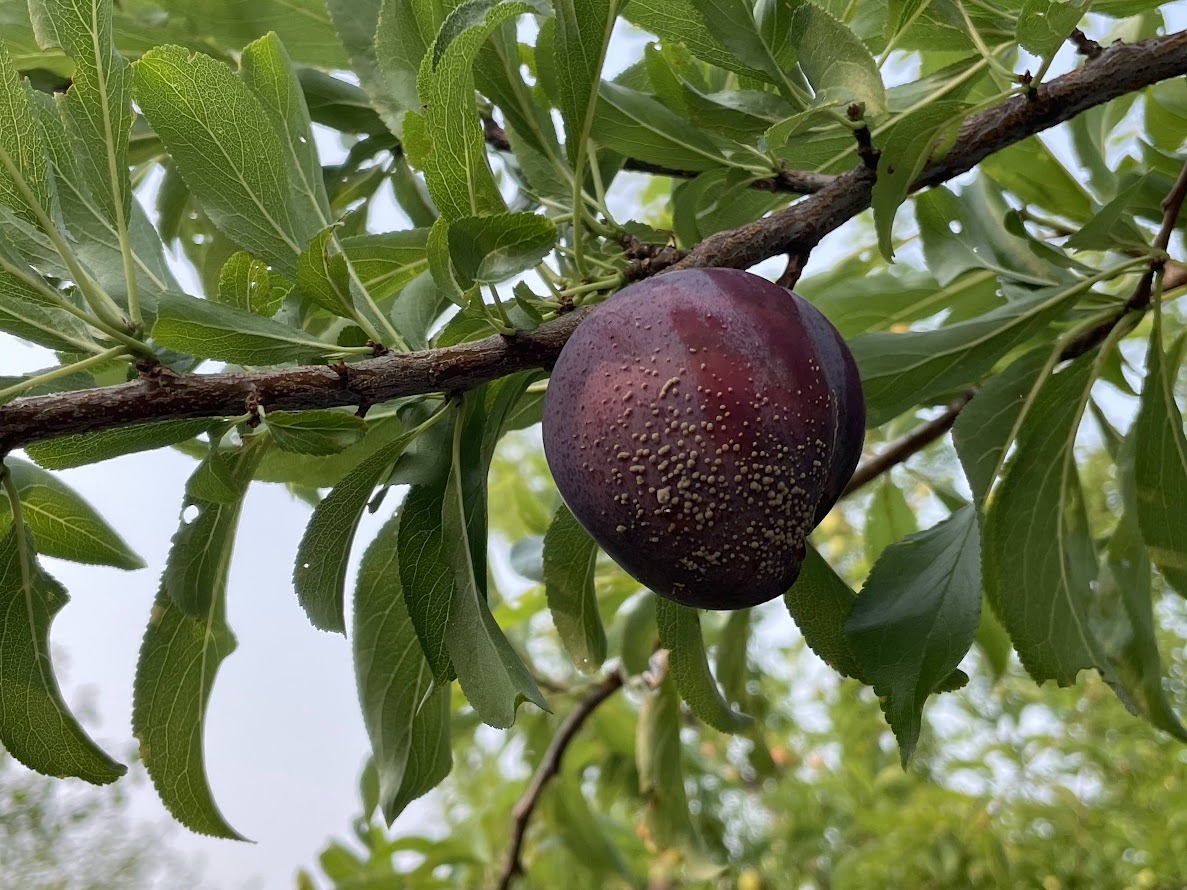West central Michigan tree fruit update – July 27, 2023
Tart cherry harvest is finishing up, and early peach and plum varieties are being harvested this week.

Weather update
Temperatures have been moderate with highs in the upper 70s and 80s degrees Fahrenheit according to the Hart Enviroweather station. There have been multiple rain events over the past week. Based on the Hart weather station for July 26, current DD accumulation is 2078 DD42 and 1327 DD50. Fruit are sizing well (Figure 1), and harvest for early plums and peaches has begun.
Thunderstorms brought rain on July 25 and 26. According to the Hart weather station, 1.38 inches of rain fell over the past 2 days. Chances of rain are also predicted on Friday and Saturday, July 28 and 29. The rain has improved fruit size and quality overall. Growers should continue to irrigate to maintain adequate soil moisture for water and nutrient uptake as needed, particularly for young trees. According to the U.S. Drought Monitor, Oceana County is rated as abnormally dry (D0), and portions of Mason County are rated as abnormally dry (D0), moderate drought (D1), and severe drought (D2). More details about the U.S. Drought Monitor can be found on the National Drought Mitigation Center website.
More information and reports on normal weather conditions and departures from normal can be found on the NOAA Climate Prediction Center website, NOAA U.S. Climate Normals website, NOAA Climate Normals Quick Access Page (which may be searched by region) and Midwest Regional Climate Center website.
Watch the full weather outlook from MSU meteorologist Jeff Andresen.
Crop update
Apple fruits in Oceana County are sizing well. Average fruit size for Zestar was 69 millimeters. Empire fruit size was 50 millimeters. Minnieska average fruit size was 67 millimeters, Honeycrisp average fruit size was 61 millimeters, and Jonagold fruit size was 57 millimeters. For early apple varieties, some growers have applied sunburn protection materials. To improve fruit color, installation of reflective fabric can be used 10 days to three weeks before harvest.
Primary scab is over! During the rain events on July 20 and 22, spore rods were monitored for apple scab spores. No apple scab spores were detected. With increased rainfall, summer rots of apple may be of concern such as bitter rot, black rot, and white rot. Management for sooty blotch and flyspeck is also needed.
Tart cherry harvest is finished for many growers, and fruit quality was high across the region. Spotted wing Drosophila larvae are present in unharvested cherries. Cherry leaf spot risk has been low this season. There was a light infection period reported on July 25. While there were wetting events reported for July 20 and 26, there were not enough wetting hours for infection according to the Enviroweather model for Hart.
Peach fruit size for the variety, Venture, averaged 49 millimeters in size at the West Central Michigan Research and Extension Center (WCMREC). Brown rot was observed in plum on July 24 (Figure 2). Wet humid conditions are ideal for brown rot development for plum nectarine, peach, and other stone fruit. Scout for brown rot in orchards, particularly where brown rot pressure has been high in the past. Fruit on trees with high crop loads or damaged fruit are more susceptible to disease development.

Pear fruit size averaged 43 millimeters for Bartlett pear at the WCMREC in Hart. Sooty mold has been observed where pear psylla populations are present in the region.
Pest and disease update
Aphids populations are increasing again in some orchards, and management of aphid populations may be needed. Trap counts below are averaged across three sites in Oceana County. Japanese beetles are also present and will need to be managed if populations are high.
Summer pests
Codling moth counts were 0.3 moths per trap on July 24.
Dogwood borer was observed this week with an average of 39 borers per trap.
Obliquebanded leafroller was trapped at two adults per trap.
Oriental fruit moth was trapped at nine moths per trap.
San Jose scale symptoms of red spots on fruit have been observed in pear from first generation scale. Find summer management recommendations for San Jose scale here.
Apple maggot has been trapped at the Trevor Nichols Research Center.
For pest and disease management recommendations, please refer to Fruit Management Guide (E-154) for product guidelines.
For more information about regional reports, please visit the Michigan State University Extension website.



 Print
Print Email
Email


